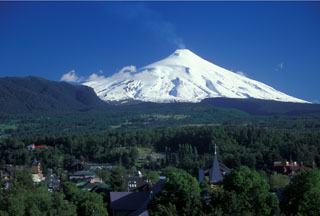Report on Villarrica (Chile) — June 2002
Bulletin of the Global Volcanism Network, vol. 27, no. 6 (June 2002)
Managing Editor: Richard Wunderman.
Villarrica (Chile) General decrease in activity during February-May 2002
Please cite this report as:
Global Volcanism Program, 2002. Report on Villarrica (Chile) (Wunderman, R., ed.). Bulletin of the Global Volcanism Network, 27:6. Smithsonian Institution. https://doi.org/10.5479/si.GVP.BGVN200206-357120
Villarrica
Chile
39.42°S, 71.93°W; summit elev. 2847 m
All times are local (unless otherwise noted)
Our last report described activity at Villarrica during January 2001 (BGVN 27:02) through January 2002, when incandescent lava was observed in the crater and ballistics were ejected ~80-150 m. At that time explosions generally occurred every ~1-10 minutes and degassing sounds were occasionally heard.
During February through at least May 2002, sporadic observations showed a general decrease in activity. Degassing noises were sometimes heard; however, no incandescence or ballistics were reported. A crater visit on 9 April revealed that no incandescence or explosive noises occurred. The surface of the lava lake, last seen on 19 January, remained low (~200 m below the crater rim). On 10 April, explosions occurred every ~10-13 minutes.
Geological Summary. The glacier-covered Villarrica stratovolcano, in the northern Lakes District of central Chile, is ~15 km south of the city of Pucon. A 2-km-wide caldera that formed about 3,500 years ago is located at the base of the presently active, dominantly basaltic to basaltic andesite cone at the NW margin of a 6-km-wide Pleistocene caldera. More than 30 scoria cones and fissure vents are present on the flanks. Plinian eruptions and pyroclastic flows that have extended up to 20 km from the volcano were produced during the Holocene. Lava flows up to 18 km long have issued from summit and flank vents. Eruptions documented since 1558 CE have consisted largely of mild-to-moderate explosive activity with occasional lava effusion. Glaciers cover 40 km2 of the volcano, and lahars have damaged towns on its flanks.
Information Contacts: Proyecto de Observacion Villarrica (POVI), Wiesenstrasse 8, 86438 Kissing, Germany (URL: http://www.povi.cl/).

